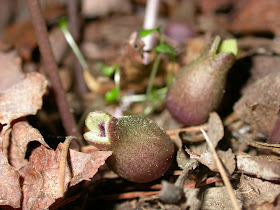While in Missouri last week visiting Justin, Dana, and Eli Thomas, we took advantage of a beautiful early spring day and visited the Huzzah River at Fish Trap Preserve of the Ozark Regional Land Trust. In addition to simply wanting to get some fresh air, we also had the goal of searching for a newly described species of leatherwood, Ozark Leatherwood (
Dirca decipiens), an early flowering shrub currently known only from Kansas, Arkansas, and Missouri. Justin knew that there was leatherwood in the floodplain of the Huzzah River at this location, but he hadn't seen the population since the new species had been described. We easily located a large population of leatherwood (the largest population Justin or I had ever seen), but unfortunately it all turned out to be Eastern Leatherwood (
Dirca palustris).

According to a paper by Aaron Floden, Mark Mayfield, and Carolyn Ferguson, there are several differences between the more common Eastern Leatherwood and the newly described (and as yet, rare) Ozark Leatherwood. The inflorescences of Eastern Leatherwood are on elongating peduncles, whereas those of Ozark Leatherwood are essentially sessile. The upper surfaces of the bracts of Eastern Leatherwood usually are covered by dark brown pubescence; those of Ozark Leatherwood are covered by white to light tan pubescence. The calyx in Eastern Leatherwood is unlobed (with erose, crenulate, or undulate margins), whereas the calyx in Ozark Leatherwood is four lobed (with entire to crenate margins). The leaves of Eastern Leatherwood are usually glabrous, whereas the leaves and twigs of Ozark Leatherwood are always pubescent. Finally, the fruit of Eastern Leatherwood are hairless at the tip, whereas those of Ozark Leatherwood have trichomes present at the tip. It has also been noted that Ozark Leatherwood is most often found on north-facing bluffs and slopes, often with oaks and junipers; Eastern Leatherwood is a species of low woods and floodplains.
Although we struck out on the new leatherwood, the day was still quite productive. We had little trouble finding another of our targets, Powder Gun Moss (
Diphyscium foliosum). Also, several ephemerals, including Cut-leaved Toothwort (
Cardamine concatenata), Spring Beauty (
Claytonia virginica), Harbinger of Spring (
Erigenia bulbosa), and False Rue Anemone (
Enemion biternatum) were in bloom. We also had a decent day in terms of herps (at least for a bunch of botanists).

The photos directly above and below show a Little Brown Skink (
Scincella lateralis). I first noticed this skink when I saw a tail slithering through the vegetation and thought I had seen a snake. This common species, which is one of the smallest reptiles in North America, spends most of its time in the leaf litter. It is interesting to note that Little Brown Skinks can apparently see with their eyes closed, as they have transparent disks in their lower eyelids.

Little Brown Skinks are known from much of the eastern United States (New Jersey to Kansas, south to Florida and Texas), as well as from northern Mexico.

We also turned over numerous logs and rocks and found several of the salamander species shown directly above and below, which I believe is a Southern Red-backed Salamander (
Plethodon serratus). Like many other salamanders, this species spends much of its time under debris in moist woods. It is primarily nocturnal.

According to the Animal Diversity Web (
http://animaldiversity.ummz.umich.edu/site/accounts/information/Plethodon_serratus.html), Southern Red-backed Salamanders are found in four disjunct populations: the Salem plateau of southeast Missouri, the Ouachita Mountains in southeast Oklahoma and west central Arkansas, the Piedmont Plateau and Blue Ridge Mountains of northwest Georgia, Alabama, Tennesee, and North Carolina, and in isolated locations in central Louisiana.
Thanks to Justin and Dana for introducing us to this preserve. You can't go wrong with a hike on a spring day, as there is always so much to see.
 Mesic Upland Forest
Mesic Upland Forest Wood Anemone (Anemone quinquefolia)
Wood Anemone (Anemone quinquefolia) Jack-in-the-Pulpit (Arisaema triphyllum)
Jack-in-the-Pulpit (Arisaema triphyllum) Wild Ginger (Asarum canadense)
Wild Ginger (Asarum canadense) Spring Beauty (Claytonia virginica)
Spring Beauty (Claytonia virginica) Squirrel Corn (Dicentra canadensis)
Squirrel Corn (Dicentra canadensis) Dutchman's Breeches (Dicentra cucullaria)
Dutchman's Breeches (Dicentra cucullaria) Wild Geranium (Geranium maculatum)
Wild Geranium (Geranium maculatum) False Rue Anemone (Enemion biternatum)
False Rue Anemone (Enemion biternatum) Lapham's Phlox (Phlox divaricata ssp. laphamii)
Lapham's Phlox (Phlox divaricata ssp. laphamii) White Trillium (Trillium grandiflorum)
White Trillium (Trillium grandiflorum) Prairie Trillium (Trillium recurvatum) - interesting pointed petals that are more open than normal
Prairie Trillium (Trillium recurvatum) - interesting pointed petals that are more open than normal Prairie Trillium (Trillium recurvatum) - one of the strangest forms I've ever seen, with not quite yellow petals, but definitely lacking the pigment that you normally see
Prairie Trillium (Trillium recurvatum) - one of the strangest forms I've ever seen, with not quite yellow petals, but definitely lacking the pigment that you normally see Downy Yellow Violet (Viola pubescens)
Downy Yellow Violet (Viola pubescens) Longspur Violet (Viola rostrata)
Longspur Violet (Viola rostrata) Common Blue Violet (Viola sororia)
Common Blue Violet (Viola sororia) It's hard to find a happier dog than one amongst the spring wildflowers.
It's hard to find a happier dog than one amongst the spring wildflowers.































